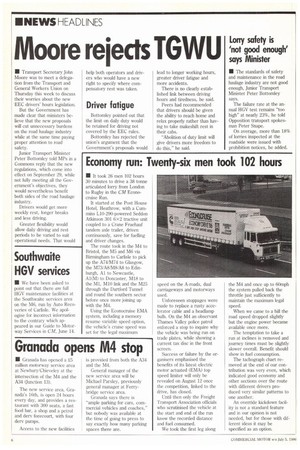Economy run: Twenty-six men took 102 hours
Page 8

If you've noticed an error in this article please click here to report it so we can fix it.
• It took 26 men 102 hours 30 minutes to drive a 38 tonne articulated lorry from London to Rugby in the CM Econocruise Run.
It started at the Post House Hotel, Heathrow, with a Cummins L10-290-powered Seddon Atkinson 301 6x2 tractive unit coupled to a Crane Fruehauf tandem axle trailer, driven continuously, save for fuelling and driver changes.
The route took in the M4 to Bristol, the M5 and M6 via Birmingham to Carlisle to pick up the A74/M74 to Glasgow, the M73/A8/M8/A8 to Edinburgh, Al to Newcastle, Al(M) to Doncaster, M18 to the Ml, M10 link and the M25 through the Dartford Tunnel and round the southern sector before once more joining up with the M4.
Using the Econocruise EMA system, including a memory resume variable speed option, the vehicle's cruise speed was set for the legal maximum speed on the A-roads, dual carriageways and motorways used.
Unforeseen stoppages were made to replace a rusty accelerator cable and a headlamp bulb. On the M4 an observant Thames Valley police patrol enforced a stop to inquire why the vehicle was being run on trade plates, while showing a current tax disc in the front screen.
Success or failure by the organisers emphasised the benefits of its latest electric motor actuated (EMA) top speed limiter will only be revealed on August 12 once the competition, linked to the drive, has closed.
Until then only the Freight Transport Association officials who scrutinised the vehicle at the start and end of the run know the recorded distance and fuel consumed.
We took the first leg along the M4 and once up to 60mph the system pulled back the throttle just sufficiently to maintain the maximum legal speed.
When we came to a hill the road speed dropped slightly but the engine power became available once more.
The temptation to take a run at inclines is removed and journey times must be slightly slower overall. Benefit should show in fuel consumption.
The tachograph chart removed at the end of our contribution was very even, which indicated good economy and other sections over the route with different drivers produced very similar patterns to one another.
An override kickdown facility is not a standard feature and in our opinion is not needed, but for those with different ideas it may be specified as an option.




































































































